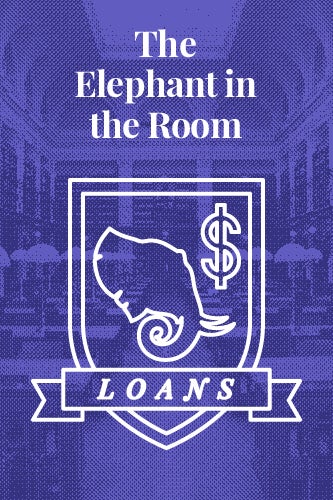Up until a few years ago, almost everyone agreed that college was, without a doubt, absolutely, 100%, the ticket to the good life.
And to some extent, that’s still true. College gradsearn 84% more than high school graduates, according to a 2011 study. But, we also pay tens — and in some cases, hundreds — of thousands of dollars for that education, taking on massive debt to finance it and graduating into a shaky marketplace that doesn’t guarantee a job for even the highest achievers.
So…has higher education turned into a scam? Is it really worth what we’re paying for it today?
With Congress and President Obama finally striking a compromise this week, over student-loan rates, we figured it was time to really dig into it: Why college is so freaking expensive, where that money is going, and most importantly, what should we have known when we were 17 – that we didn’t?

This past year, tuition at a four-year public college for an in-state student averaged out to $8,655 according to the College Board, with a low of $4,278 in Wyoming and a high of $14,576 in New Hampshire (snowboarding is expensive, yo). But, that’s a drop in the bucket, compared to the cost of a private school. If you decide to go that route, tuition bounces up to nearly $30,000 a year. And, that doesn’t factor in other expenses like miscellaneous fees, textbooks, food, and housing (and most definitely not beer or spring-break money). With all of the incidental costs included, a “moderate” budget for attending a private institution comes to about $43,289 a year — but extending all the way up to $61,977, if you happen to attend NYU, the country’s mostexpensive school.
And yet, it wasn’t always this way. In 1980, you could have gotten an education plus room and board at a four-year public institution for just $3,449 in today’s dollars. But, college tuition has been increasing at about twice the rate of inflation, faster even than healthcare costs. It’s especially bad out west, where from 2007 to 2012, California and Arizona state colleges jacked their tuition by 72% and 78% respectively, charging their students thousands more to attend each year. With college tuition averaging a price increase of about 8% a year, according to Finaid.org, if you were to have a baby today, paying for it to go to college would cost three times what it does now.

Hold up, though. Focusing out these sticker prices is a bit misleading. That’s because it’s a rare student who slaps down a check for the full price of tuition. When you factor in free money from grants and scholarships, the average net pricefor a four-year public college drops to a doable $2,910 a year, while private college drops to $13,380 a year. Still pricey, but not quite as panic-attack-inducing.
Carrie M. Collins, Vice President of Institutional Advancement at University of the Sciences, says 99% of students at her college receive some sort of financial aid. She also points out that, especially at a private institution, tuition doesn’t pay for a full year. “Tuition may be high, but tuition doesn’t even cover the cost of the entire academic year to support faculty, facilities and the cost of operations.” It typically covers just 70 to 80%, the rest of which is covered by donors and interest earned from the endowment. And it’s worth noting that public institutions are so cheap because they get your tax dollars.
So, your tuition, plus taxpayer money, plus donor money, plus endowment money, plus grants and scholarships, all combine to make it possible for you to attend school for one year. Where is all this money going?

A lot of the increase in tuition comes from, paradoxically, tuition discounting. As colleges try to make higher education more and more inclusive, covering tuition for lower income and all-star students has driven up the sticker price. More importantly, as state funding for public institutions has dried up, colleges have increasingly turned to students and parents to cover more of their education. (New Hampshire is actually as expensive as it is because the state doesn’t give as much to its public colleges.)
But, there are other factors, too. “There is increased demand and limited supply,” says Robert Mendenhall, President of Western Governors University.“Regulations and accreditation restrict entry into the marketplace, so the existing universities hold close to a monopoly in higher education. You’ve had very few new institutions start up in the past 30 years.”
Given this, it’s not surprising that colleges are so bad (or don’t care) about operating efficiently to keep administrative costs down. It’s a rare college where you can pay tuition, sign up for classes, get help, and do other basic tasks all online, instead of waiting in line at whatever administrator’s office. And seriously, how many deans do you really need?
Mendenhall also points to rankings as the culprit of increases in costs completely unrelated to actual learning. “Universities are trying to recruit the best students, and the way you recruit them is to build fancier dorms and fancier gyms and fancier cafeterias. There’s a lot of spending going to attract the best students.” Collins agrees. “In terms of fancy bells and whistles, it’s what we have to do to remain competitive with other institutions. Are you going to go to a place with a good workout facility, or the one who doesn’t [have one?]”
In short: Less state funding, more grants and scholarships, bloated administrations and the sweet new gym with a rock-climbing wall are all reasons why college tuition is so damn high.

You can’t discuss college costs without addressing student loans, which have been accused of enabling schools to become glorified summer camps. After all, students would do a better job of shopping around for good value in education if it weren’t so stupidly easy to take out a $30,000 loan, right? The practice of giving these large loans to students was initially based on the assumption that they would graduate and secure a good job, then pay the money back. Unfortunately, that hasn’t turned out to be the case.
In the past five years, the average student-loan debt for each borrower has risen 30% to $23,829. More than half of the loans are in deferment, meaning the borrowers are pushing off payments for a few years as they scramble to find a job that pays enough to afford hundreds of dollars in monthly loan payments. And 15% of loans that aren’t in deferment are delinquent. No wonder — half of 2012 grads are unemployed or underemployed.
Things aren’t likely to get better. The interest rate for federal student loans doubled on July 1st to 6.8%, when the Senate couldn’t agree on the plan. This week, they’ve come to abipartisan compromise that should maintain the previous lower rates, but keep them tied to the market — and will hopefully be passed by Congress before they leave for the August recess.
A program started under the Bush administration and expanded by Obama does give borrowers some hope, though. It lets federal borrowers enroll in an Income-Based Repayment program, where they pay a certain amount of their income for 10 to 25 years, then the rest of the loan is forgiven. Another program forgives your loan if you work in public service for 10 years. These programs are “mind-blowingly generous” but extremely underutilized by borrowers, the majority of whom don’t know they exist.
So, just in case we’re not being clear enough: If you are struggling with federal student loans, get on anincome-based repayment plan. Stat. You’re welcome.
(If you took out private loans, however, all we can say is good luck with that. They suck.)

Okay, given all this, are there colleges out there that are cheap but can still give you a good education? The short answer: Yes. But, there will be tradeoffs.
First, you could do your first couple of years at one of the dirt-cheap community colleges (which have seen tuition increases of just 1%) before transferring to a four-year institution that’s recognized as more prestigious. Those first couple of years are usually taken up with core classes anyway. In fact, if you’re willing to forego the idea of “brand-name education,” you could get your entire degree there. Not a bad idea, given that many community-college grads are currently out-earning bachelor degree holders.
If that’s not the avenue for you, you can also get a free education at a military academy like the Naval Academy or West Point — you just have a serve in the Armed Forces afterward, for a certain amount of time. Or you could go to a well-accredited online university, which gives you all the learning you need to land a job, without the football team, lap pool, and sorority houses that aren’t required, per se. For example, Western Governors University, is based on competency (do you understand the material?) instead of time as measured in semesters. So, you can move at your own pace and graduate faster, which means you’ll spend less money. The average student there spends $18,000 getting a bachelors degree, and tuition hasn’t been raised in five years.
Finally, certain prestigious schools like Harvard, Princeton, Yale, Stanford, and Columbia actually are a better return on your investment, because of the amount of grants and scholarships that they give out that bring the net cost down, and the high earning potential of grads. But, there are also some dark horses you might not have heard of, like Harvey Mudd, Polytechnic Institute, and SUNY – Maritime College, according to CNN. And of course, more obviously, MIT and Caltech. Yup, when in doubt, go technical instead of liberal. The world really does have too many lawyers and not enough engineers, and you will be paid accordingly, post-grad.
Illustrated by Ammiel Mendoza
Click HERE to read more from Refinery29.

Be the first to comment